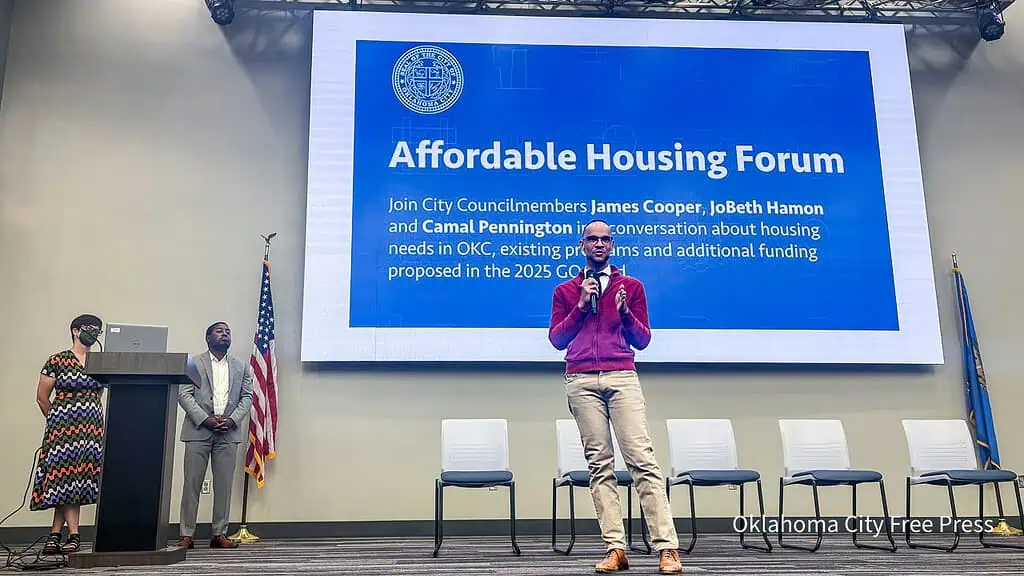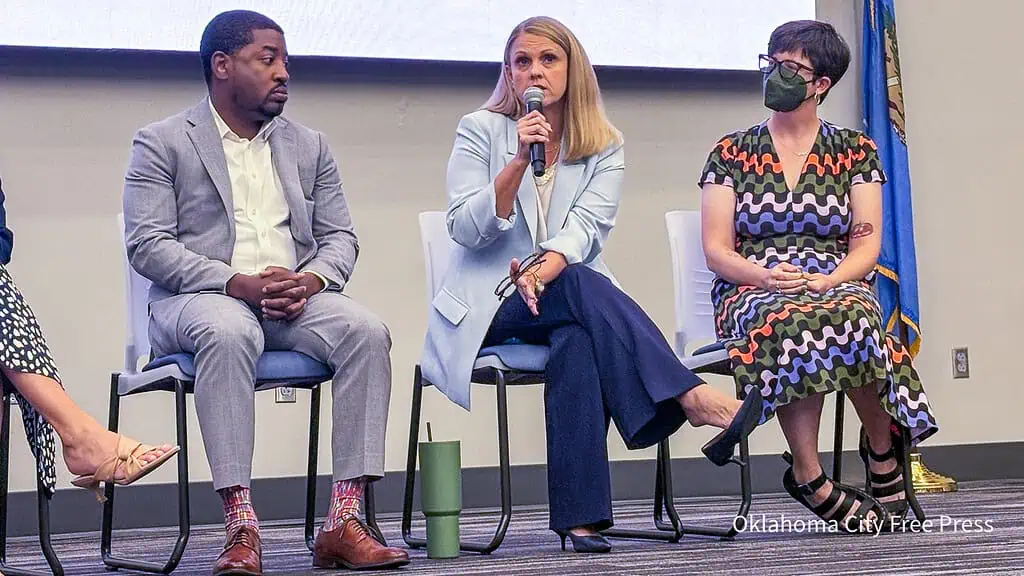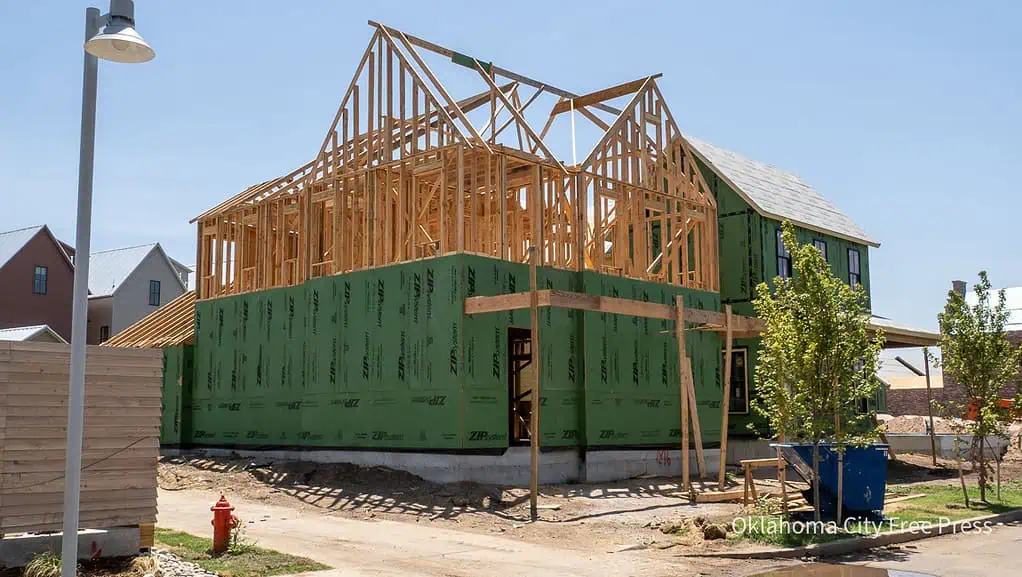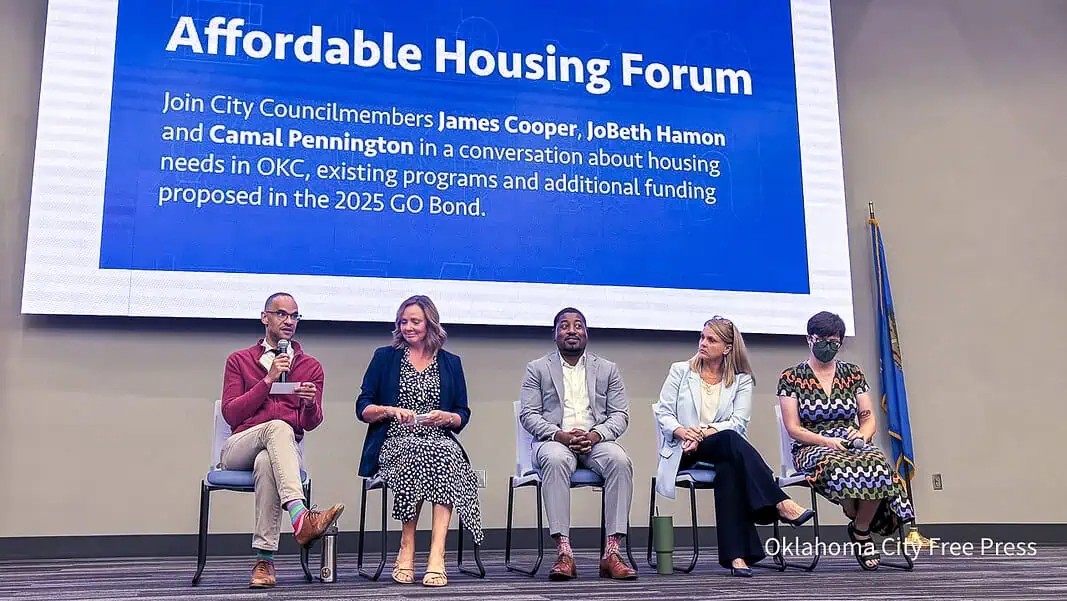OKLAHOMA CITY — Oklahoma City is facing a historic crisis of affordable housing, but as City leaders laid out in a public forum Tuesday, they hope to combat it from all angles with a historic and all-encompassing new approach.
Organized and hosted largely by Ward 2 City Councilman James Cooper, the event at Metro Tech was an opportunity for City leaders to lay out the goals, accomplishments, and admitted challenges of reducing housing need and increasing programs and supply ahead of next month’s public vote on the proposed $2.7 billion General Obligation bond.

City officials gave building developers, community stakeholders, and curious residents a crash course in the state of Oklahoma City’s ongoing housing crisis and in the myriad ways it can be addressed through the GO bond funding and beyond.
With a public election scheduled for October 14th, the GO bond is the next step toward helping to fund and potentially expand housing efforts in the city, with $50 million allocated expressly in the proposal for affordable housing programs.
But it was also a chance for the leaders of those City programs to tout achievements and to lay out plans for the future, both specifically in terms of continuing and developing on recent successes and more broadly, including nods to potential future policy initiatives over the next decade.
“I’m someone who always likes to identify the problem,” Cooper told the audience before turning the mic over to fellow counselors Camal Pennington (Ward 7) and JoBeth Hamon (Ward 6) for introductions before in-depth presentations outlining the City’s homeless services and housing efforts.
“Once you identify the problem, then you can confront the solutions,” Cooper said. “And I am grateful to say I think there are some solutions facing us here today.”
Rehousing
The bulk of those potential solutions came in presentations from Strategy Implementation Managers Jamie Caves and Shannon Entz.
Caves, the strategy implementation manager for homeless services, heads up the City’s Key to Home Partnership, a public-private partnership connecting City services to private funding and housing suppliers.
She used her presentation to outline the recent successes Key to Home has had with their Encampment Rehousing Initiative, working with unhoused residents to move them directly from the street and into housing, resulting in 25 encampments closed and a 43% reduction in their targeted population in just two years.
Providing quick stability and direct housing support, she said, is something that has positive ramifications across demographics.
“Homelessness affects everyone in our community,” Caves told the audience. “Whether you’re experiencing homelessness or you’re a business owner or you’re just going to the park. We all are affected.”
Housing affordability
Entz then offered the evening’s longest presentation, breaking down the City’s sprawling and recently adopted Housing Affordability Implementation Plan, or HAIP, and her new role as strategy implementation manager for housing.
The HAIP takes a holistic approach to efforts to increase the housing supply of OKC while simultaneously bringing costs down, incorporating private partnerships and resources to leverage already overburdened City services and funding.
“Partnerships are absolutely key,” Entz said. “The city cannot do this without our entire community.”

She touched on some of the ways that they hope to achieve that boost to the housing supply, such as streamlining and reducing the permitting and approval process for builders, rehabbing existing homes and buildings to make neighborhoods more appealing for infill development, and championing the City’s new ADU allowance.
She even touted the remarkable successes of the Strong Neighborhoods Initiative, focusing primarily on infill development and rehab in lower-income neighborhoods, resulting in a boost to the housing supply and property values that have risen to outpace even trendier, in-demand areas like Mesta Park.
But Entz was also clear about the challenges facing housing efforts in OKC.
“Our eviction rate is 14%, that’s 7% higher than the national average. Not acceptable,” she said. “We have 77,000 households in Oklahoma City that are cost-burdened. 62% of those are renters. And our loan denial rates are 11.5%. That is 4% higher than the national average.”
Building concerns
Following the presentations, the full group of speakers took the stage to address audience comments and questions, which had been written and handed in on index cards to be read by Cooper.
Some of those sought clarification on numbers or statistics that had been presented, but at least two questions raised concerns about building developers and property owners and the roles that they are playing in these efforts.
One raised the issue of out-of-state and out-of-country corporate developers buying up cheap land and property in OKC and either holding it with no development or developing it cheaply with poor maintenance and oversight.
“It’s a problem, there’s no doubt about it,” Entz replied, citing cases of non-profit developers attempting to buy vacant lots for development, only for corporate developers to buy them first and raise the value beyond the means of a non-profit developer.
“As we go through this process over the next year or two of really developing and fine-tuning our policies, that is something we have to think about,” she said. “But I think we have to be honest about the likelihood of things like that getting addressed at the state level.”
Local developers
Another submitted question read by Cooper took aim at even the local developers involved as stakeholders in the City’s new public-private Housing Advisory Group partnership, asking pointedly how residents can take the group seriously when so many of its members are for-profit developers.

It was Hamon who closed out the event by acknowledging the necessity of those voices in the City’s market-driven housing economy, but also by reassuring that the lower-earning and cost-burdened are well-represented in the group’s ranks, even by some counselors themselves.
“I’m one of those people,” Hamon said. “I only make $70,000 a year as a household between me and my spouse, so I am one of those people, and I know James is one of those people, so you have people on council that feel that.
But we’re in the minority, so we need that pressure from the community to say we want to keep the affordability, the community building, and the community development as the guiding star for these efforts.”
Brett Fieldcamp is our Arts and Entertainment Editor. He has been covering arts, entertainment, news, housing, and culture in Oklahoma for 15+ years, writing for several local and state publications. He’s also a musician and songwriter and holds a certification as Specialist of Spirits from The Society of Wine Educators.










